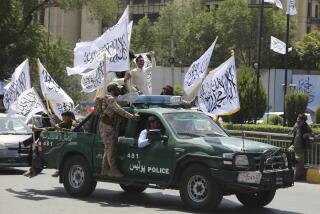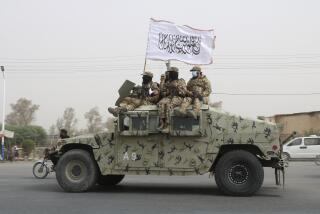Twisted Laws Fueled Reign of Terror by Talib Police
KABUL, Afghanistan — It took a doctor to impose the Taliban version of God’s law. He wore a blue surgical mask under a white hospital cap, which left a narrow slit for him to see through. The convict would know him only by his eyes.
Ghulam Farooq, an apprentice ironsmith accused of theft, was ordered to lie on dying brown grass near the center of the Kabul Sports Stadium in July 1998 so that a capacity crowd could watch the Taliban enforce its strain of Sharia, Islamic law.
More than three years later, Farooq, 26, bowed his head to hold back tears as he described the final minutes before the silent doctor jabbed a hypodermic needle into his hand and put him to sleep.
The mullahs had already finished their speeches about justice and the Koran and the will of God. The only sound Farooq remembers hearing as he drifted off were a few shouts from the stands.
“They were crying out to the Talibs not to do it, but they didn’t care,” he recalled Saturday.
When Farooq awoke about two hours later, he was in Kabul’s Wazir Akbar Khan Hospital, minus his right hand and left foot. He was screaming in pain. The Taliban hung his severed hand and foot on lampposts as a warning to others.
By the time the Taliban seized Kabul in 1996, most people in the Afghan capital were so sick of being terrorized by armed robbers and rapists, murderers and torturers among some factions that now make up the Northern Alliance that they welcomed the movement’s ruthless justice. But one reign of terror quickly replaced another.
The vicious morality police of the Taliban’s Ministry for the Promotion of Virtue and Prevention of Vice routinely beat and jailed people for violating a list of edicts so long that few ordinary Afghans could remember all the things they weren’t allowed to do.
Women who tried to follow every rule by completely covering themselves and leaving home escorted by a close male relative could still be thrashed in the street because their shoes made a clicking sound.
Judges were known to dispense justice without lawyers or witnesses. Some were famously corrupt.
“It was peace, but like in a prison,” said Dr. Zekreya Yosufi, an orthopedic surgeon who helped care for dozens of amputees. He also saw the stone-battered or bullet-ridden corpses of men, and at least one woman, who had been executed in Kabul’s stadium.
Yosufi remembers a Canadian surgeon from the international Red Cross, Dr. Ken Foster, asking the Taliban for permission to sew a thief’s hand back on soon after he was delivered to the hospital.
“They told him, ‘No. What do you think we cut it off for?’ ” Yosufi, 28, said.
The unknown doctor who severed Farooq’s hand and foot under order of a Taliban court made the cuts at his wrist and ankle. Without more surgery, he couldn’t be fitted with artificial limbs.
Three more operations reduced his left leg to a stump just below the knee. His right arm now ends below the elbow. Only after the operations could the Red Cross fit him with artificial limbs.
To find doctors to carry out the amputations, the Taliban first relied on Kabul’s 400-bed military medical center, according to Yosufi.
“Later, doctors in the hospital didn’t stay late on Fridays for fear of being ordered to go for cutting,” he said. “But they couldn’t avoid it. The Taliban would punish them if they didn’t.”
As Afghan doctors resisted, the Taliban depended more on Pakistani physicians, who were among the more fanatically loyal foreign volunteers, Yosufi said. He personally never was called on to carry out Sharia amputations.
The Taliban wasn’t the first to impose Sharia in Afghanistan. It had been tried three years earlier by some of the same moujahedeen factions that started a civil war in 1992 after they drove out Soviet troops in 1989.
But under the moujahedeen, the law had more to do with the power of a gun. The Taliban twisted Sharia to suit its own, cruel understanding of right and wrong that was shaped in part by a tribal code called the pushtunwali.
The Pushtuns, who gave birth to the Taliban militia in 1994, lived by ancient rules that set out how hosts must care for and protect guests and their property, the way men must defend women’s honor or how killings should be avenged.
Under the pushtunwali, a slain victim’s family had the right to choose “blood money” in compensation, and before the Taliban, that was the preferred settlement. But the Taliban insisted on taking a life for a life.
Afghan critics of the Taliban complain that the way the movement combined Pushtun tribal rules with Islamic law badly distorts both. Sharia, for instance, requires no less than four male witnesses to an adulterous act, but the Taliban routinely executed people without meeting that strict standard of proof, Yosufi and other Afghans said.
He saw the body of one woman delivered to the hospital after she was stoned to death. Taliban soldiers refused to tell him why she had been killed, he said.
“They brought in one woman who was skinned and another who was chopped into pieces and carried in a box,” the surgeon added. “When we asked about the women’s bodies, they said it was none of our business.”
Farooq insists that he did not steal money as his Taliban prosecutors alleged, and claims that they were persecuting him because of his Tajik ethnic roots in the Panjshir Valley north of the capital, where the Taliban faced its toughest opposition. Tajiks are one of the main ethnic groups in the Northern Alliance.
His home was in south-central Kabul’s Qoway-e-Markaz district, but he had spent a night at his sister’s house in another neighborhood. He was stopped as he left her house in the morning, he said.
Taliban soldiers took him to a military court, and when he refused to admit his guilt, locked him up for 16 days and regularly beat him, he said. But he still insisted that he was innocent.
His trial in front of High Court Judge Qazi Sayed Rahmand lasted 10 to 15 minutes, Farooq said. He had no lawyer, and there were no witnesses either. No one even said how much money he was accused of taking, Farooq said.
Yosufi said Rahmand was known for his cruelty and was eventually dismissed by the Taliban for taking a bribe to set a killer free and ordering an innocent man from the same village beheaded in his place.
Farooq was found guilty on a Thursday and loaded into a four-wheel-drive vehicle the next day. He had four armed Taliban guards, and a second vehicle filled with more Taliban followed on the journey to the stadium in south Kabul.
Farooq said his hands and legs were in chains. He was squeezed in beside another prisoner, whom he identified as a boy about 15 years old named Gul, from a town east of Kabul on the road to Jalalabad.
“He was crying in the car,” Farooq said. “They said he had killed a Talib. It wasn’t clear whether he had killed or not, but he kept saying he hadn’t. I told the boy, ‘They won’t kill you,’ but he didn’t believe me.”
The teenager was hauled out first when the convoy stopped in the center of the stadium. Farooq said he watched from about two yards away as the guards forced Gul to kneel on the soccer field, still crying, and a Taliban soldier killed him with three rifle shots from behind.
After Rahmand addressed the crowd, stressing Farooq’s guilt, a doctor stepped forward from a circle of about 150 Taliban soldiers, injected the sedative and then cut off Farooq’s hand and foot.
As a disabled man and a convicted robber, Farooq had two strikes against him. He would have had little chance to making a living if not for a break from Alberto Cairo, an orthopedic surgeon and international Red Cross delegate in Kabul.
Eight months ago, Cairo hired Farooq to water trees and flowers and do other odd jobs at the agency’s Ali Abad Orthopedic Center. He earns about $50 a month, more than many skilled Afghan workers, but he supports an extended family of 15, including his three children, 18 months to 5 years old.
He is marked for life, and even though the Taliban has left Kabul, he knows that thousands of ordinary people in the streets showed up on a summer day to watch him being mutilated.
“It was not a good thing to watch us. It was like entertainment for them,” Farooq said.
Kabul stadium was empty Saturday afternoon except for a few regulars who hang around. One was a boy named Ahmad Farhad. The 12-year-old was sitting in the stands with three friends when the Taliban executed a man four months ago.
The boy said he just followed an excited crowd as it rushed into the stadium, and thought that he was going to see a soccer game.
Farhad knelt on the field, just as the condemned man had, to demonstrate how the executioner had placed his hand over the prisoner’s forehead. Reaching from behind, the executioner drew a long knife, normally used for killing sheep, across the convict’s throat.
It took about three minutes to sever the head completely, said Farhad, whose story was confirmed by several men who stood next to him. The boy wasn’t boasting about what he had seen. He looked frightened by what he knew.
Farhad said he wasn’t sure what the man’s crime was because the mullahs had addressed the crowd in Pashto, a language the Tajik boy doesn’t understand. He remembers the crowd’s reaction clearly though. “People were just sitting there, sad,” he said. “Some of the women were screaming.”
On the stadium wall, just behind the seat where the boy sat that day, were two signs that carried messages to the people from their Taliban rulers. “A nation that has defeated two empires in one century will never be subjugated by a foreign culture,” warned one. “Sport is good for making a good society,” advised the other.
More to Read
Sign up for Essential California
The most important California stories and recommendations in your inbox every morning.
You may occasionally receive promotional content from the Los Angeles Times.










